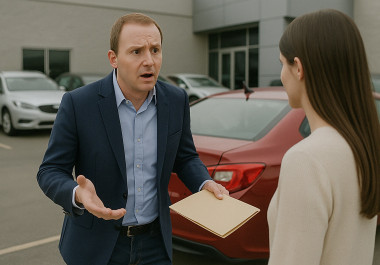You can find plenty of great deals on used, seized and salvage cars in our online vehicle auctions here at RAW2K, so it’s probably no surprise that we attract our fair share of first-time drivers, looking to get their first set of wheels out on the road. If you’re not an experienced driver though, getting behind the wheel can be a daunting experience - and that’s not to mention keeping track of all the maintenance!
So if you’re considering buying your first car - or you’ve just bought one already - you may have some questions about how to keep them in check. Below, we’ve answered some of the most common queries we often hear!
Why is insurance so expensive?
Let’s be honest, this is one of the first questions that so many young drivers tend to ask - and with good reason! It mainly comes down to the idea of risk - insurers weigh the amount they ask for against the likelihood that they’ll have to pay out. The higher the risk of a payout, the more they ask for in premiums to offset that cost.
The bad news is that young drivers in the 17-24 demographic are judged to be particularly high-risk drivers, and so have to pay the highest premiums. In fact, according to the AA, about a quarter of all road accidents involve a driver aged 17-24.
If you’ve bought a used or salvage car like a Category N, this can also sometimes have a further effect on your insurance. (If you need more information, we’ve written a handy guide to insurance on Category N cars before on the blog.)
Don’t despair quite yet though. If your insurance quote seems eye-wateringly high, it might be worth talking to your insurer. Some might be willing to offer additional options, such as black-box insurance, to bring down the cost a bit.

How often do I need an MOT?
Legally, your car is required to have an MOT test after the third anniversary of its registration. That means if you’ve bought a brand new car, you won’t need to take it for its first MOT test until its third birthday. However, if you’ve bought a used car or salvage vehicle (and if you’re reading this, chances are that you have), then you’ll need to be taking it for annual inspections right from the off.
If anything, this might actually provide you with some welcome peace of mind, given the varying condition that some salvage cars can be sold in. MOT tests are pretty exhaustive, covering lights, brakes, steering, tyres, seatbelts, your exhaust, windscreen, suspension, and electrical equipment.
How often should I take my car to be serviced?
As well as your MOT, the general recommendation is that you should take your car to have a full service every 12,000 miles, or every 12 months (whichever one comes first). Depending on the condition of your car and how often you drive it, it might also be a good idea to consider an interim service once every 6000 miles, or once every six months.
What’s the difference between an MOT and a service?
The key difference is really that an MOT is mandatory and focused on maintaining minimum safety standards for your car, whereas a service is optional and aims to ensure that your car is running in peak condition and efficiency.
If you like, you can think of it between having a checkup at the doctor’s versus an appointment with a personal trainer. The first will only ensure that you’re well enough to function, whereas the second is concerned with making you the best you can possibly be. Otherwise they’re very similar in lots of ways, and in fact both cover many of the same mechanisms and components.

It might already be easy to see why so many drivers opt to save themselves the cost of a service, and only pay out each year for an MOT instead. But while a service does indeed result in an additional short term cost, it’s not one to be dismissed offhand.
A service is a great opportunity for your mechanic to get some preventative maintenance done, which can help solve problems before they develop into serious safety hazards. This is not only safer for you and any passengers, but it’s always cheaper to solve the problem in the early stages of its development - saving you a potentially hefty bill much later on.
Plus, there’s always the fact that it gives your car some always-welcome TLC, and a car that’s well looked-after tends to have a much longer lifespan.
What does a service cover?
Most garages offer varying different levels of services, but a standard service will generally cover one or more of the following:
- Engine oil change and / or a filter replacement
- A check of the lights, tyres and exhaust
- Condition and operation of brakes and steering, including steering alignment
- Making sure that your engine is properly ‘tuned’
- Checking fluids and coolant
- A check of your suspension
What parts and components should I watch out for?
While you might not have the skills or equipment of a professional mechanic yourself, it can still be helpful to keep your eye on the condition of several components of your car, to ensure that your car stays safe and roadworthy.
1. Tyres
You’ll need to ensure that your tyres always have optimum air pressure by frequently checking their tread depth. The tread depth is essentially the distance between the top of the tyre’s rubber to the bottom of its deepest grooves. The UK’s legal minimum tread depth is 1.6mm, as anything below this means that your tyres’ grip will become less effective - which can have a measurable and dangerous impact on your control and braking distance.
2. Fluids
Just like humans, your car needs plenty of fluids to stay healthy. This includes water, engine oil, coolant and screenwash, so make sure to check on these levels often to ensure that they’re sufficiently topped up.

3. Wipers and windscreen
Your wipers may eventually start to wear down over time, which can affect your ability to clear dirt and debris from your windscreen. And inspect the windscreen itself often, so that you can be sure there are no marks or cracks. While a small crack might not seem such a big deal, it can aggravate dazzle and glare from sunlight and other car headlights. It could even spread (sometimes with little to no warning) into an even larger and more dangerous crack, which can obscure your vision. This can result in dangerous driving - and possibly even legal consequences - so don’t hang around to get it sorted!
4. Lights
We probably don’t need to explain this one in quite as much detail. You might not need your lights so much in the summer daytime, but at any other time of year they can make all the difference as to whether or not you’re essentially driving blind - and equally dangerously, invisible. Make regular inspections of your lights to make sure that they’re clear from debris, and all in working condition.
So, those are the basics! And if you’re still hunting for the best prices on a used, seized or salvage car - or even looking for a replacement for your current model - you can find a great range in our online vehicle auctions right here at RAW2K. We’ve got models from a variety of leading global manufacturers, including Vauxhall, Peugeot and Volkswagen. Why not take a look around our site, and see what you can find?




